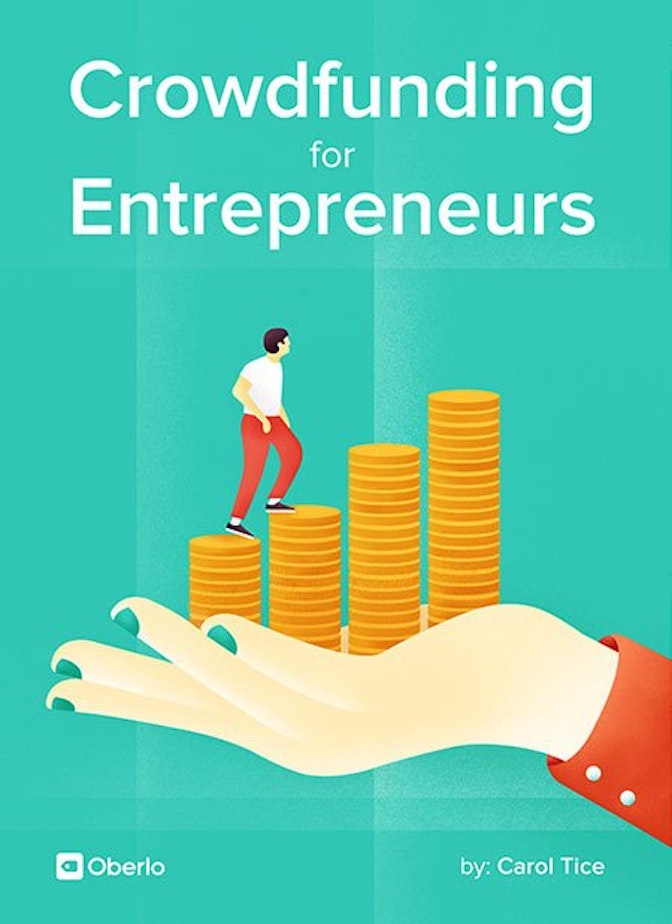One of the best ways to learn about crowdfunding is to read exactly how other startups ran mega-successful crowdfunding campaigns. Enjoy the insider tips in these crowdfunding examples, from recently successful creative startup teams in different industries. I’ve also included a rundown on the top 10 best Kickstarter campaigns of all time.
Snuggly Success: How Animoodles Raised 4X Its Kickstarter Goal
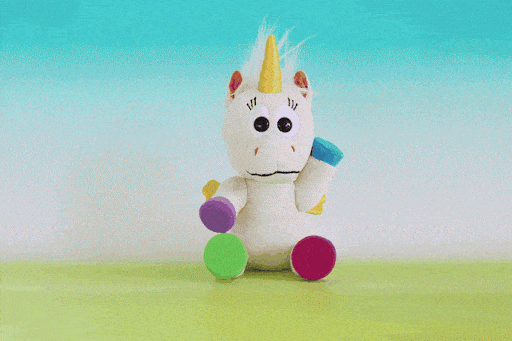
Can stuffed animals be even more lovable and fun? Animoodles says they can, when strong magnets allow a set of stuffies to be mixed into new shapes and combinations. Animoodles is also one of the most successful crowdfunding examples for a non-techy, consumer product in recent years.
Billed as “the world’s cutest building toys,” Animoodles raised just over $100,000 in its Kickstarter crowdfunding campaign, blowing past its $25,000 goal. Not bad for a first product that attracted its initial audience with a ‘mystery’ opt-in page that simply hinted the team was making something and asked for emails.
Created by a team of ex-Apple, Disney, and Pixar artists-turned-entrepreneurs, Animoodles became a crowdfunding darling by riding the cred of its team’s solid-gold work experience, coupled with the ‘awww’ factor.
In a lively, animation-filled Kickstarter campaign page, the Animoodles team revealed the concept, backstory, and feel-good mission of Animoodles (to help save endangered species). Their campaign page is a great example of successful crowdfunding marketing, with fun videos and lots of info.
Here’s co-founder and chief designer Marissa Louie with the lowdown on the role rewards played in this campaign, and how Animoodles delighted its backers:

Marissa Louie, Animoodles
“We thought Kickstarter was the best match for us, in terms of having a lot of toys, kids’ products, and design-oriented projects, compared to other crowdfunding platforms.
“Our rewards included cool, free activities and crafts, to give little touchpoints of excitement. When we hit a milestone, we’d reveal the next level, because we wanted to keep the momentum going.
“We offered Halloween stencils based on the characters, and people used them to carve pumpkins—and then posted those on Instagram (which also helped spread the word about the campaign). Our activity storybook was a coloring book but also tells a larger story about the animals, which are all endangered species.
“We had eight rewards levels in all, and we’d unlock new levels as a level got full. When we hit goal, we launched an elephant as a bonus animal, with 100% of profits going to the African Wildlife Foundation.
“We could have capped the reward levels and limited how many we sold in the campaign. Kickstarter lets you. But we wanted to build the first generation of avid fans. They’re still active a year later, sharing photos of Animoodles online.”
In wildly overselling its campaign, though, Animoodles faced a classic manufacturing test: how to deliver, on time, what turned out to be over 900 orders. (Too many bad Kickstarter crowdfunding examples have had a hot campaign, but then failed to deliver the goods.)
The tricky part was, Animoodles had designed some rewards levels as “pick any two” and “pick any three” of the five-animal set, so each order had to be customized.
Planning for production started 6 months or more before launch, Louie says. Having set an aggressive delivery date of 6 months after launch, Animoodles relied on two team members with a combined total of 50 years’ manufacturing experience, including making toys in China. One was a former director of top educational toy maker Leapfrog.
Packs that were sold as a fixed set—such as packs of all five animals in the original set—were pre-packaged at the factory, Louie says. The mix-n-match sets were shipped as individual plush toys and packaged at a U.S. facility. With careful planning, Animoodles was able to deliver in 3 months, overachieving to surprise its fan base.
Louie’s tips? You want to hit your funding target fast. Animoodles hit $25,000 in 11 hours—and then Louie got busy alerting the media. The result was several favorable mentions during the campaign that helped draw more backers.
What’s next for Animoodles? In September 2018, the company was plotting its return to Kickstarter to sell its second six-pack of plush toys. The original set is for sale online and in select toy and gift shops.



Rewards + Equity: How Canada’s Hardbacon Raised $52K – and $250K
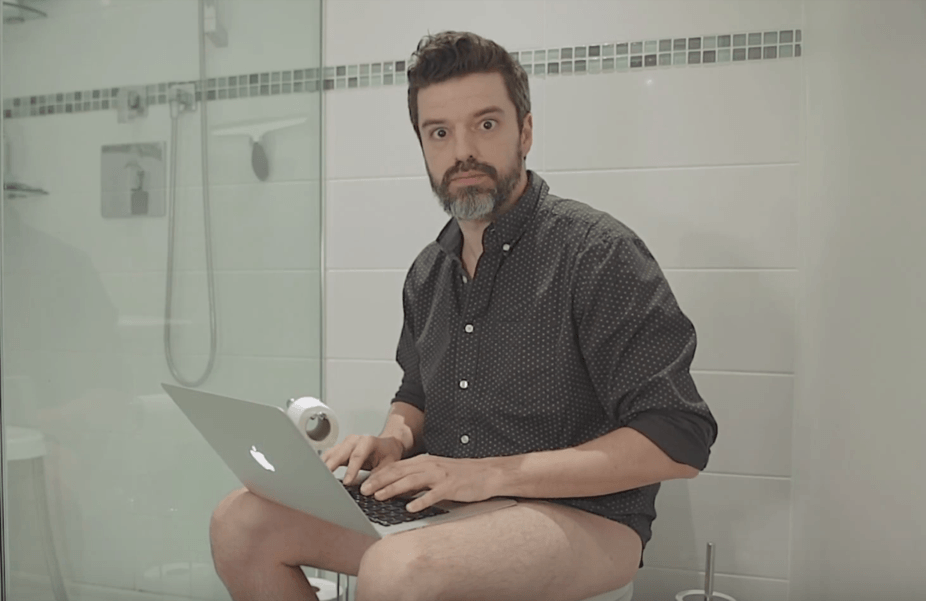
Montreal finance-education startup Hardbacon started small in crowdfunding, with a $7,600-goal campaign on Ulule for an online finance course that, at the time, didn’t yet exist.
→ Click Here to Launch Your Online Business with Shopify
CEO and co-founder Julien Brault chose Ulule in 2017, after meeting the platform’s CEO when Ulule opened a local office. At the time, Brault says, he was casting around for a business idea that would use the website-development and lead-generation skills he’d honed at past jobs.
What he came up with was an online course in investing. Not Another Boring Course About Investment was marketed as “100% guaranteed unboring.”
What drove this seemingly low-key, small campaign to wildly overachieve and raise nearly $52,000? A hilarious short video featuring Brault, his cat, and a guy on a toilet, demonstrating Hardbacon’s zany, fun approach.
Hardbacon took full advantage of Ulule’s advanced translation features, which meant its page would display in French or English automatically, depending on the user’s preference. He said Kickstarter couldn’t offer this seamless experience.
Out of all the startup crowdfunding platforms out there, Ulule was the only one that actively sought Hardbacon’s business, offering tips on how online fundraising works, he says. Trying to raise such a small amount on Kickstarter, Brault doubted they’d get featured, especially since their own backer list was under 800 people.

Julien Brault, Hardbacon
With modest reach on their own, Brault says Ulule helped Hardbacon ramp up fast.
“Ulule told us how to run a campaign,” Brault says. “You usually make mistakes and get good at crowdfunding over multiple campaigns. Instead, at Ulule, we were in their office, they had their manager help us. We had a bug once, and sat and talked to their guy while he fixed it.
“They taught us, ‘your biggest marketing asset is your contributors.’ So we started reaching out to influencers. I’ll give you a secret: Most are charging money, and won’t share your stuff free. We built a list of people who had a huge following who weren’t stars, but had enormous reach.
“We’d build quotes with their face, and they thought it was cool. They’re flattered. One said, ‘Your video is so fun, I’ll share it free.’ Some [second-tier] influencers aren’t in the business of monetizing their reach.”
How did Hardbacon go viral, from its relatively small fan base? Brault says the startup got a little help from Nouncy, a social tool that helps you encourage all your fans to post something at the same time.
If 150 people around Montreal’s tech scene tweeted about Hardbacon in the same hour, hundreds of people would see multiple social media connections talking about Hardbacon all at once. This piqued interest and brought new backers.
This initial success got Hardbacon launched, and it quickly grew into a much broader financial-education platform, more of a Mint.com for Canadians.
A year later, it was time to leverage that initial crowdfunding success and take it to the next level. With more knowledge of how to do online fundraising, the startup embarked on an equity crowdfunding round for the Hardbacon app.
This time, Hardbacon chose Canadian equity crowdfunding platform GoTroo. Hardbacon hit its maximum target and raised $250,000 on GoTroo in roughly 30 days in summer 2018.
Why GoTroo? Brault cites a novelty element of using a newer, emerging platform (GoTroo was founded in 2015), and he says he liked the Canadian focus.
The big plus: The equity raise could go for general business purposes and growth, rather than being earmarked for one product.
The relative rarity of equity crowdfunding helped Hardbacon get press attention, too. Brault says over a half-dozen publications mentioned the GoTroo campaign—driving traffic to the campaign page and yielding social proof in the form of quotes Hardbacon added to the page.
Different media were interested in different angles, Brault says. Financial-services writers liked that Hardbacon included a financial-planner tool, and tech outlets noticed the app got featured in Apple’s “New Apps We Love.”
In the GoTroo equity campaign, the startup sold a roughly 18% equity stake, at $.90 per share, to over 360 investors. Minimum investor commitment was 110 shares. Hardbacon was valued at $1.5 million going into the transaction.
Hardbacon’s own users were a major source of funding, especially in the first days, says Brault. Some $30,000 was raised on day one, with the campaign hitting $100,000 four days in.
The secret sauce this time? Text messaging, press mentions, and a snappy hashtag:
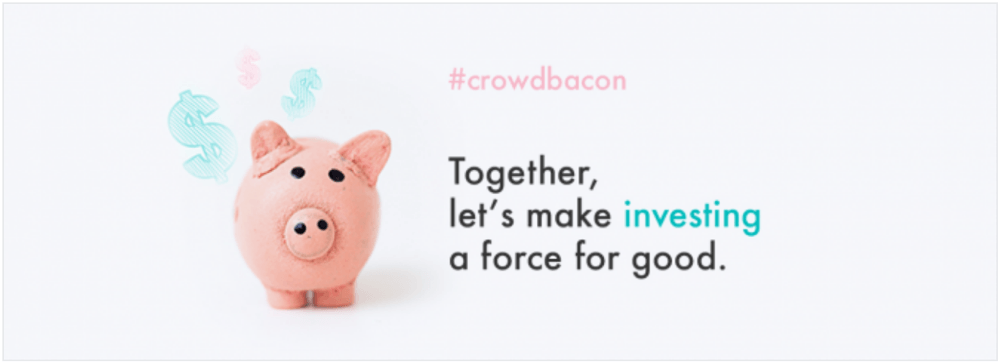
Software such as TextMagic enabled Brault to send out mass text messages that appeared individualized to hundreds of followers at a time. This spread the word quickly.
Going For Gold: Sweat Cosmetics Leverages Its All-Star Team
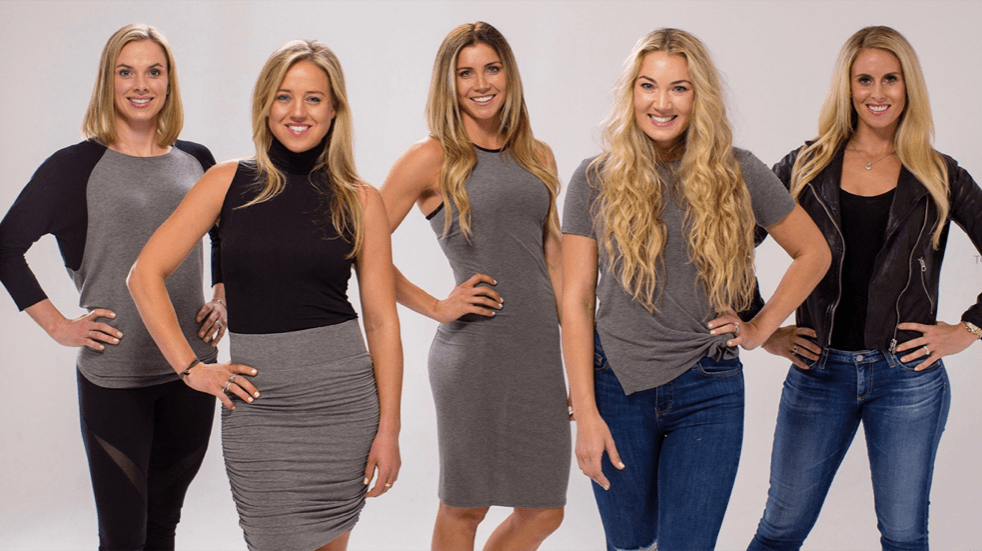
The beauty business is tough to crack for new entrants, and there are few equity crowdfunding examples in this sector. But Sweat Cosmetics in Denver made it happen in April 2018, with a big assist from its amazingly photogenic, all-woman founder team of former pro athletes.
Sweat creates makeup athletes can wear while they work out, making the founders the perfect spokeswomen for their products. The team consists of all former pro athletes, including two-time Olympic soccer gold medalist Lindsay Tarpley.
Sweat raised $255,000 from over 500 investors in April 2018 on Indiegogo’s First Democracy VC equity crowdfunding platform. Investors received preferred stock in Sweat.
Co-founder Leslie Osborne said the campaign had a $50,000 floor, and anything above that was a plus. Putting the equity crowdfunding campaign and legal paperwork together was a 6-month process, Osborne says.
Strengths that weighed in Sweat’s favor for an equity campaign:
- A previous small seed-funding round of $30,000 or so in 2015
- A sales track record of more than $1 million in revenue to date
- Sweat’s marketing firm, Agency 2.0, had a relationship with First Democracy
- Can you hum the Olympic theme?

Leslie Osborne, Sweat Cosmetics
Marketing was another strength, as the team was well-connected thanks to their sports careers. They started the campaign with a 20,000-name email list and 48,000 Instagram followers.
“Our network is our strongest suit,” says Osborne. “One thing we learned is that in equity, you can’t tell anyone you’re doing a campaign until it goes live. That’s when you start marketing.
“We had 60 days once we went live, and Agency 2.0 did a great job promoting it with Facebook ads and other digital media. We’re a female-founded, female-run company, and we tried to hit home on that.
“Our ads did great, and we were sending out email blasts. We spent $10,000 on Facebook.”
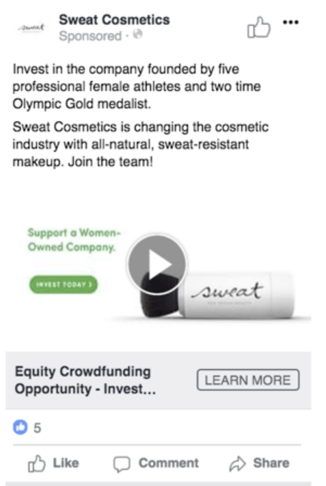
As with many other successful crowdfunding examples, Sweat grabbed media attention by quickly hitting its $50,000 minimum. Their skyrocketing fundraise caught the eye of Money magazine and USA Today. The latter featured Sweat’s execs in a cover story on crowdfunding that dropped while their crowdfunding campaign was still under way.
Like many product-focused companies that do equity crowdfunding, Sweat also gave investors perks like $100 gift cards for Sweat products. Big-money investors were treated to a New York City Sweat Party event.
Sweat plans to spend its crowdfunding for business growth: new-product development, marketing, and inventory replenishment, Osborne says.
Osborne’s tips: The higher your profile is going in, the more likely you’ll strike gold on media exposure during your campaign. Sweat’s execs had hit Good Morning America in 2016, and the company had products reviewed in women’s magazines prior to the campaign.
Also: Shop around on legal paperwork, if you’re doing equity. Osborne says they got several bids for low-cost help, went with another provider than First Democracy’s own service, and saved several thousand dollars.
Magic Top Spins to Success on Both Kickstarter and Indiegogo

“How much could you raise online, if you had the next fidget spinner?”
That’s the marketing handle startup Fearless Toys Ltd. of Jersey City, NJ, gave its first product in mid-2018. The company developed the LIMBO, a self-balancing, gyroscope-driven spinning top that usually spins for over 4 hours.
A novelty in what Fearless calls the “FunTeach” sector, the mesmerizing top can help get kids interested to learn how gyroscopes work. Simple but innovative, the toys became one of the hottest rewards-based crowdfunding examples of 2018, earning Fearless almost $688,000 on Kickstarter from over 8,700 backers.
This successful crowdfunding campaign’s secret sauce? Fearless got the LIMBO into the Guinness World Book of Records. The Guinness win helped LIMBO garner at least a dozen major press mentions, from outlets including Mashable, Digital Trends, and Yahoo! News, exposing the gadget to thousands of potential backers.
It likely also didn’t hurt that the audience for the product was, well, everyone who needs a holiday gift for the kid (or grown-up nerd) on their list.
[highlight] Fearless’s lengthy Kickstarter campaign page is a textbook example of how to generate excitement. It includes several good crowdfunding video examples. Graphics and GIFs also cover various topics—how the top works, how it’s manufactured, and how LIMBO performs in a variety of challenging situations. [/highlight]
A series of videos and GIFs show the LIMBO spinning on a tomato, a squishy laptop case, a lit candle, on top of Fearless designer Yoav Amir’s bald head—even in a hypnotic time lapse of a 4-hour spin on a Hong Kong beach.
With four different aluminum and titanium models, Fearless offered an extravaganza of 16 different pay levels (a half dozen would be more typical).
At the low end, $49 backers got one LIMBO, a keychain, and charging cable. At the top level, 73 backers paid $299 for an exclusive, Kickstarter-only World Record kit that included the titanium model and extra batteries that allow the top to spin for 40 hours. Another 50 backers paid $289 for a package of all four models.
Since their Kickstarter smash, Fearless transferred over to Indiegogo to raise even more through Indiegogo’s In Demand feature. That pushed the total raise to over $750,000 by September 2018. Fearless is promising December 2018 delivery, to capture those holiday sales.
One key alliance may help Fearless make that deadline: It partnered with Breaking Games, the indie game-publishing arm of game printer Ad Magic, to put out the LIMBO. Teaming up with an established publisher no doubt lent Fearless more credibility and gave backers confidence the techy top would actually get made.
Nearly $12K a Month For Safety Videos: A Patreon Case Study

Kevin Morris’s online business began from his personal passion: The entrepreneur from Ft. Worth, Tx., just wanted motorcycle riders to avoid getting injured.
He ended up combining that passion with his corporate experience in web development—for companies including American Airlines—to create a successful online business. Few crowdfunding examples seem as picture-perfect; Morris is basically living the dream of getting paid to do what he loves.
A longtime motorcycle-safety instructor, Morris set up a website, MCrider.com, and a YouTube channel, to get safety tips out to as many bikers as possible.
Then, he began looking for ways to make the effort pay off beyond the occasional YouTube ad commission. He learned about Patreon and set up shop there in early 2017.
To get the tips out to the most riders, he decided not to charge riders for the videos, so sites like Kickstarter weren’t a fit for this project. Getting support from his fellow motorcycle instructors and enthusiasts, who shared his love of riding, seemed natural.

Kevin Morris, MCrider.com
“I wanted to give back to the motorcycle community and help keep people safer,” he says. “I was posting weekly content and getting a pretty good response. Then, I created a mobile-enabled MCrider Field Guide. It allows riders to go out in a parking lot and practice, holding the app.
“When I first started on Patreon, I got two patrons. When I started promoting it and mentioning I was on there, it started growing. I got in the habit of never being afraid to ask for the sale. So there’s a quick intro video and then I say, ‘Hey, subscribe to get access to the field guide and forums.’ I never thought it would turn into a full-time business, but it did.”
The tight-knit motorcycle community liked Morris’s commitment to helping—and his pricing. He has just three patronage tiers: $3, $5, and $50. All get access to the field guide and forums.
At $5, patrons can also suggest video-safety topics for Morris to cover. The $50 patrons get swag including sponsor credit in his videos, MCrider apparel, and a vote on what videos he’ll make next.
Over 2,600 patrons now support MCrider, paying an average of $4.50 a month. It’s successful crowdfunding that’s different than probably most startup founders imagine—but who wouldn’t like to make a steady living from their business?
Morris’s tip? Give away valuable content to get patrons interested. He gives away most of his content in his weekly free safety videos, then rewards patrons with deeper help on chat forums and with his field guide.
Building his online business has turned out to be a blessing for another reason: Knee problems now keep Morris from working as an instructor. He’s fortunate to have his Patreon business to replace the lost income.
Inside Nomad Trading’s “No Marketing” Energy-Drink Triumph
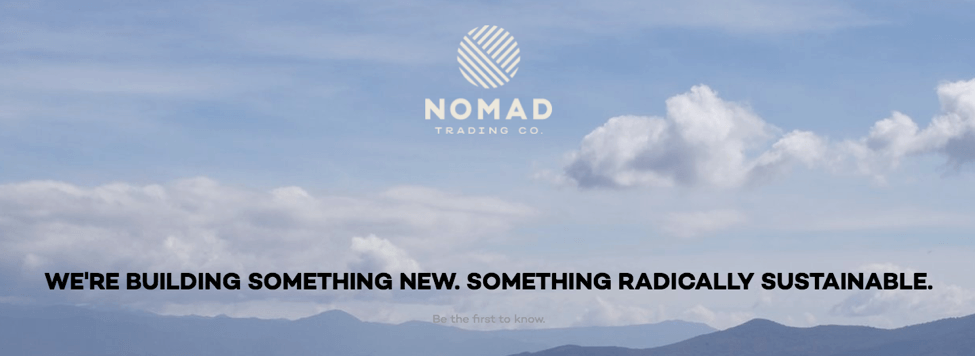
Sometimes, when you create a new product, you just want to see what people think of it—people who aren’t your personal friends and family. There are many crowdfunding examples where companies do online fundraising mostly as a form of market research.
That’s what Brooklyn-based Nomad Trading Co. decided to do in 2018, debuting a new, chemical-free energy drink on Kickstarter to gauge consumer interest.
The company had created a tea drink in the past, and—with their mission of radical sustainability—they were interested to find ways to reuse coffee-fruit discards, which are a major source of agricultural waste.
Co-founder Max Keilson says the idea was to put the Nomad Energy Drink they formulated from coffee cherries up on Kickstarter without a big marketing push, to see if it would attract interest from people who knew nothing of the company or its mission.
Marketing was minimal—the company posted to its Instagram and Facebook pages. Keilson says a few emails went out to their 800-person list, built from a simple “coming soon” opt-in page.
What they did do was ask for help from Kickstarter in creating their campaign, which included a top-level reward of an $1,800 Costa Rican trip. The result: Nomad Trading raised over $16,500, far outstripping their $5,000 goal.
“They don’t provide demographics on the Kickstarter audience,” Keilson notes. “But I had a sneaking suspicion it skews male, early adopter… and that they’re pretty heavy caffeine consumers.

Max Keilson, Nomad Energy
“So we thought it was a fit for us to test this. We wanted to know, ‘If this exists in the ether… would people buy it?’
“We spoke to Kickstarter a bit to learn best practices on how to design our page—and they were incredibly helpful. They said, ‘Once it’s ready to go live, send it over, and we’ll look it over and see if it makes sense to feature it.’
“They ended up sending it out in their newsletter, and that helped us get off to a really strong start. Kickstarter has analytics, and we saw close to 40% of our funding came from people browsing Kickstarter, who saw us in the newsletter, or in a list, or on the front page.
“We hit our $5,000 goal within 16 hours. By the end of day two, we’d hit $10,000.
“Right away, people bought one of the really high-ticket items—the trip to one of our farms in Costa Rica. Which really shocked me.
“Then, the fact that we hit goal in 16 hours did help us get a little bit of press. That probably delivered 10% more, about $1,500.”
In September 2018, Nomad Trading (no relation to gear company Nomad Lane, the travel-gear startup featured in Chapter 1), Keilson reported production was on track to ship Nomad Energy drinks to backers later that month, meeting their delivery target.
Nomad Energy drinks are also set to appear in Whole Foods on the East Coast, leveraging Nomad’s previous relationship with their region’s local buyer.
Keilson’s tips: Ask for help from your crowdfunding platform! Getting staff familiar with your campaign may help you get featured. Do all you can to hit your funding target fast, to build buzz, get press, and get discovered by site visitors.
Top 10 Best Kickstarter Campaigns of All Time
When entrepreneurs go looking for great crowdfunding examples, what they’re often looking for isn’t necessarily the most recent winners, but the all-time greats. If that’s your interest, here for your inspiration are the ten best Kickstarter campaigns ever, in terms of money raised (as of September 2018).
Not all these stories ended happily. Be sure to learn from both the positive and negative crowdfunding examples here:
1,3, and 5: Pebble Smartwatches
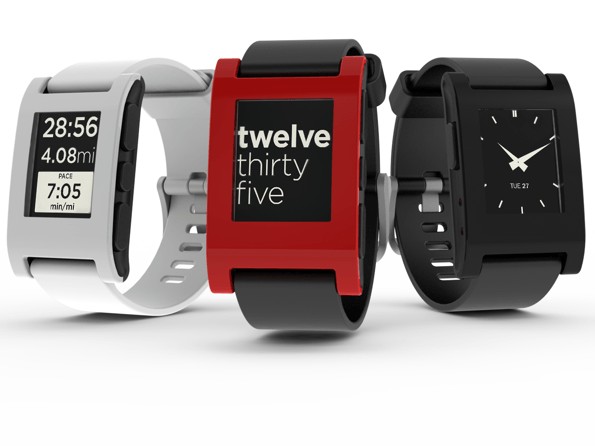
That’s right—three of the top 10 spots are occupied by the same company. Pebble Technology burst on the Kickstarter scene in 2012, raising $10 million for its E-Paper Watch for iPhone and Android. The first $1 million came within 24 hours.
The company returned in 2015 to raise a #1 record ($20.3 million on a $500,000 goal) for its “better than the Apple Watch” models, cementing its reputation as the company with the best Kickstarter campaigns.
Takeaway: Early-adopter techies love unique products. Period.
Pebble’s final Kickstarter round came in 2017, when new watch models raised $12.8 million on a $1 million goal. The company cashed out big shortly afterward, with FitBit buying Pebble out for $23 million later that year.
For invaluable guidance, study this company’s products, marketing copy, and campaign pages in detail. Pebble is the ultimate successful crowdfunding example.
2. The Coolest Cooler
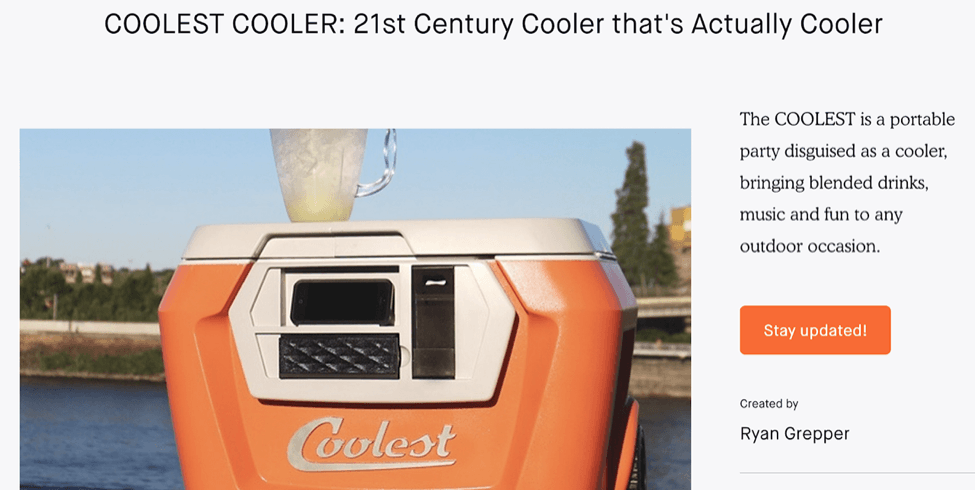
The second-biggest Kickstarter campaign ever is also known as one of the most spectacular failures in crowdfunding history. The Coolest Cooler inventor Ryan Grepper raised over $10 million back in 2013, exciting techies with its built-in USB charger, blender, Bluetooth speaker, and more.
The bad news? Coolest Cooler couldn’t deliver the product, in a classic failure to properly price and plan for manufacturing and shipping. As Mashable reported, two years later, only a small fraction of buyers had received their coolers.
At one point, investors were asked to put in additional money to get their coolers shipped. Class-action lawsuits were threatened.
Despite the PR black eye and being mentioned in numerous media stories as one of the biggest-fail crowdfunding examples, the company survived.
[highlight] If you want to know if you can bounce back from crowdfunding failure, Coolest Cooler proves you can. The company returned to Kickstarter in 2014 and successfully raised a chart-topping $13.3 million, with delivery going off without a hitch. Coolest Coolers are sold today. [/highlight]
4. Kingdom Death: Monster 1.5
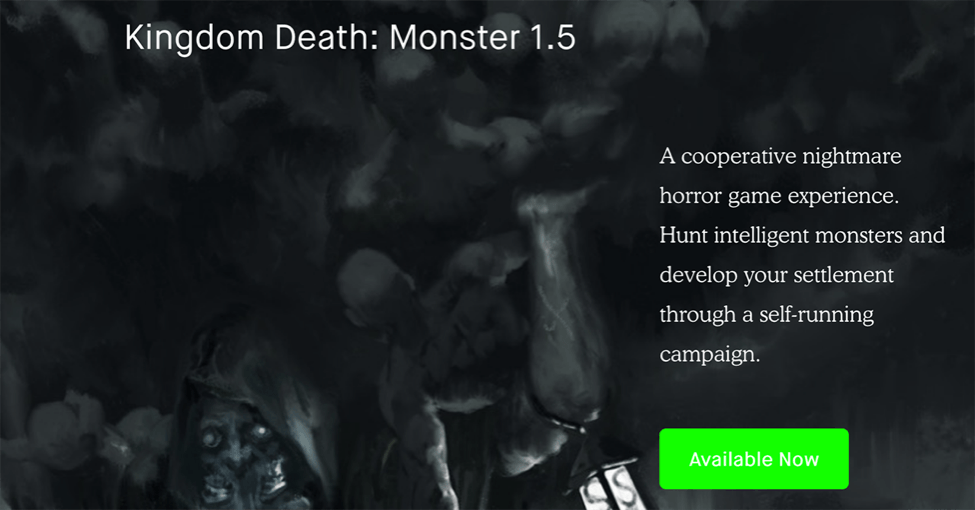
Here’s another category with many great crowdfunding examples on Kickstarter: board games. Kingdom Death’s “cooperative nightmare horror game experience” raked in almost $12.4 million in 2017. The first $1 million was raised in 19 minutes, a Kickstarter record.
A clever angle here: Kingdom set a long timeline to deliver all the game elements, which aren’t all set to deliver until 2020. Clearly, game fans— over 19,000 of them—trusted the company to keep making game pieces for years to come.
6. The World’s Best Travel Jacket
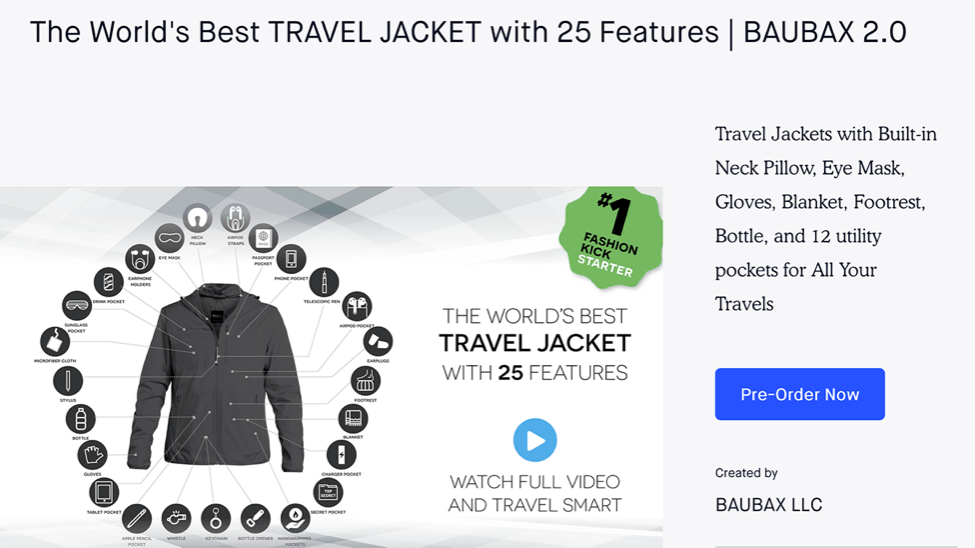
Here’s a successful crowdfunding campaign in another big Kickstarter category: techie clothing. Baubax LLC scored one of the best Kickstarter campaigns ever with this 15-featured travel jacket. After all, who doesn’t want a build-in neck pillow, eye mask, blanket, and phone pocket all built into their outerwear?
Nearly 45,000 backers craved just that, ponying up almost $9.2 million to pay roughly $100 for a jacket that would retail for more. Baubax has since racked up another success over on Indiegogo, raising $4.3 million in April 2018. Study Baubax if you want to learn how to do successful crowdfunding, as they’ve mastered the formula.
7. Exploding Kittens
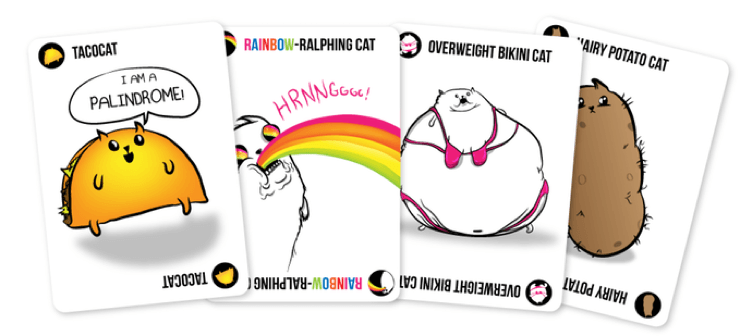
Did I mention card games are also highly popular on Kickstarter? In one of the most notable crowdfunding examples for a card game, creator Elan Lee’s zany Exploding Kittens raised $8.78 million in 2015 from a staggering 219,000 backers.
This is one of the better crowdfunding project examples for yielding fringe benefits beyond money raised. Exploding Kittens’ Kickstarter helped create huge buzz for the new game, making this the ‘it’ game gift of that holiday season.
8. OUYA Video Game Console
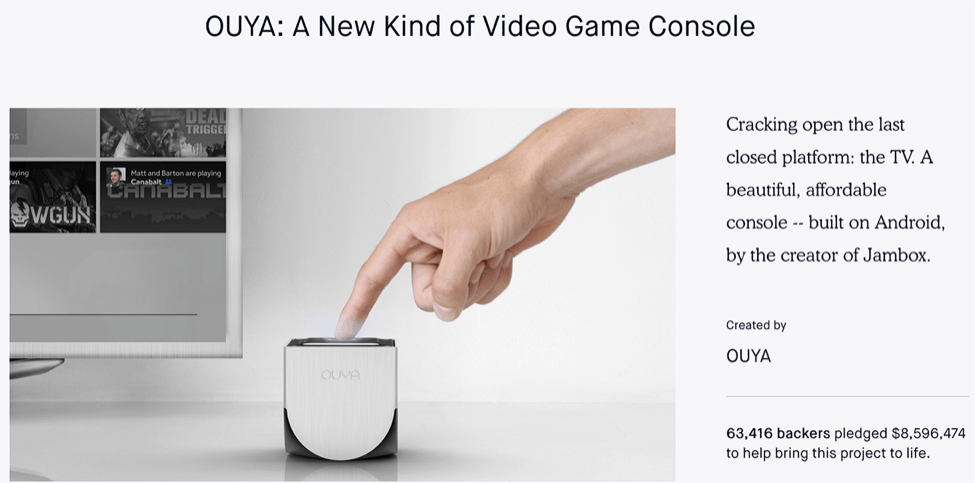
One of the best examples of crowdfunding to a tech audience here: Backers shelled out $8.6 million for the maker of Jambox’s newest thing, an elegant square console.
A solid track record helped create instant buzz for this one way back in 2012. Notably for a tech product, Ouya is still sold today, and has added more features over the years.
9. The 7th Continent
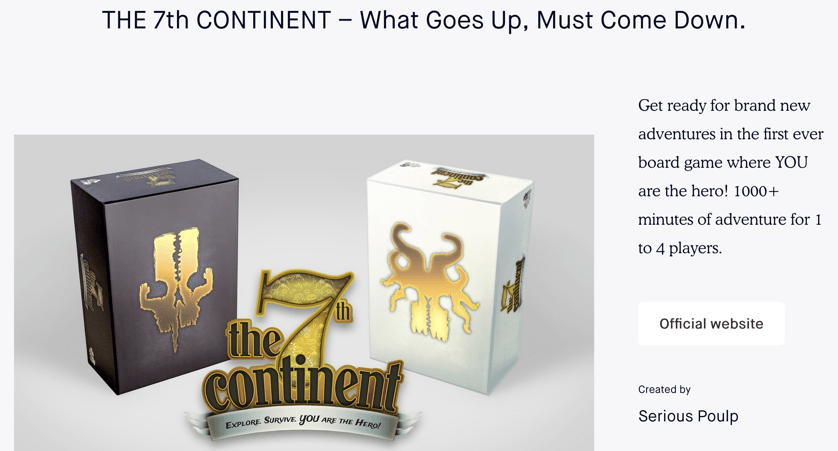
Board games triumph again, with Serious Poulp pulling in $7 million in 2017 for its cooperative game adventure The 7th Continent. This makes 7th Continent one of the newer entrants on the top ten. Poulp is due to deliver in fall 2018.
1o. The Everyday Backpack, Tote, and Sling
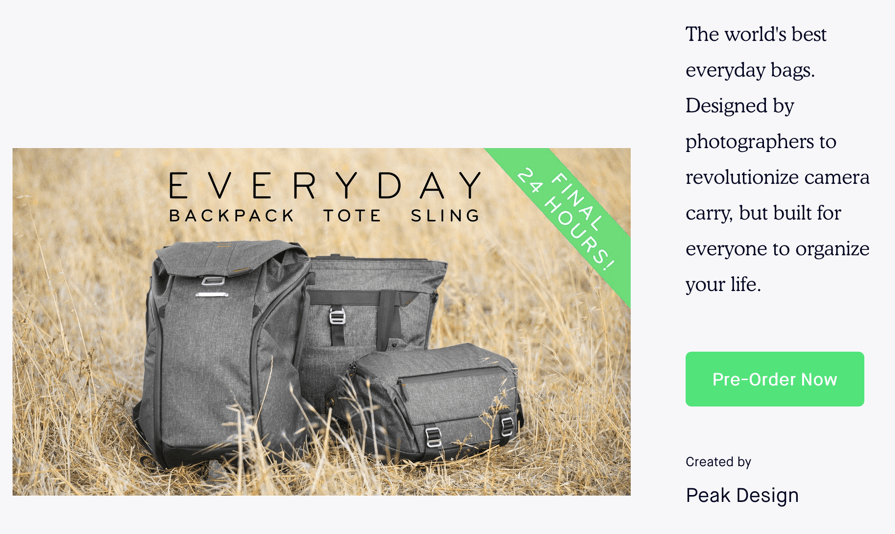
Another highly popular Kickstarter category hits the top 10 with this travel-bag entry. Peak Design’s three, full-featured travel bags were a megahit in 2016, raising almost $6.6 million.
Peak Design returned in 2018, raising $4 million for its Versatile Backpack + Packing Tools set.
The Sad Tale of #11
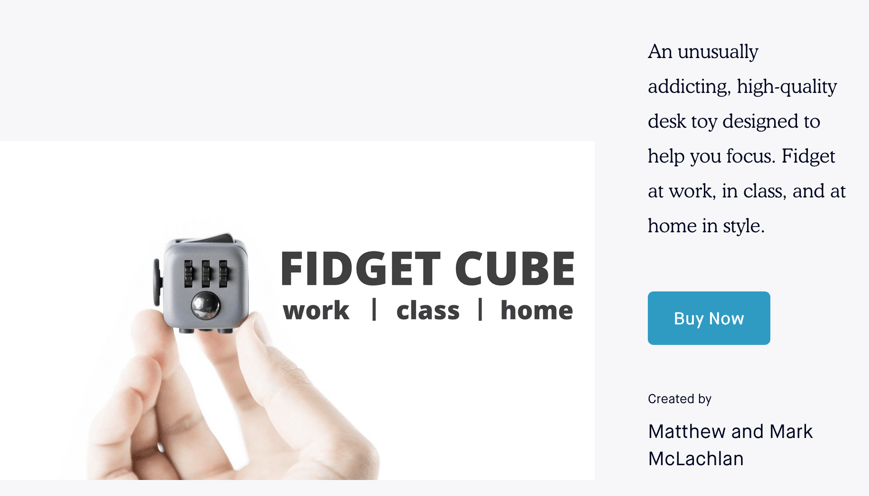
One final note about top Kickstarters: The 11th biggest winner is another notorious failure among top-grossing crowdfunding examples. The vinyl Fidget Cube hoped to be the next fidget spinner.
The gadget raised $6.5 million in 2016 but ran into delivery problems. Angry backers watched cheap knockoffs of the Cube debut for less on Amazon before they received their toys. Message: Delivery speed matters.



Harvest the Lessons
I hope these crowdfunding examples gave you tons of ideas on the best way to approach your own crowdfunding campaign. (You can always check if a new entrant has beaten the Kickstarter all-time top 10 by searching “most funded” campaigns on Kickstarter.)
Gather up the best tips, because next, you’ll see how to use them to plan and execute your own successful online fundraising.

